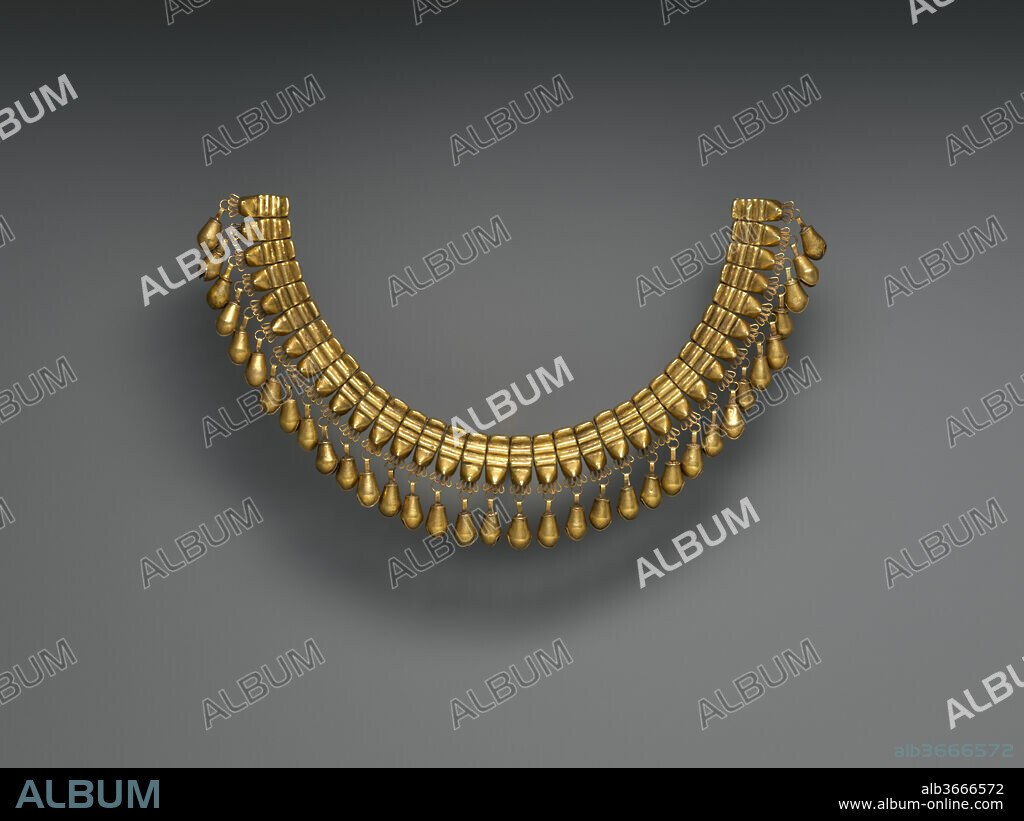alb3666572
Necklace with Beads in the Shape of Jaguars' Teeth

|
Ajouter à une autre Lightbox |
|
Ajouter à une autre Lightbox |



Avez-vous déjà un compte? S'identifier
Vous n'avez pas de compte ? S'inscrire
Acheter cette image

Titre:
Necklace with Beads in the Shape of Jaguars' Teeth
Légende:
Voir la traduction automatique
Necklace with Beads in the Shape of Jaguars' Teeth. Culture: Mixtec (Ñudzavui). Dimensions: W. (bead) 1 3/8 × L. (necklace) 15 1/4 in. (3.5 × 38.7 cm). Date: A.D. 1200-1521.
This elegant gold necklace, created using the lost-wax technique, is composed of thirty-four gold beads in the shape of the carnassial teeth (molars) of a jaguar with an equal number of rattle bells joined to them with delicate "false-filigree" loops.
Este elegante collar de oro, creado con la técnica de la cera perdida, está compuesto por treinta y cuatro cuentas de oro en forma de dientes carnosiales (molares) de un jaguar con el mismo número de campanas de cascabel unidas con delicados bucles de "filigrana falsas".
This elegant gold necklace, created using the lost-wax technique, is composed of thirty-four gold beads in the shape of the carnassial teeth (molars) of a jaguar with an equal number of rattle bells joined to them with delicate "false-filigree" loops. False filigree refers to the process where artisans, rather than applying individual strands of metal, modeled the loops in wax and then cast them, creating a delicate lace pattern. One bell--the third on the proper right--is a modern replacement. Although gold working developed relatively late in Mesoamerica (after A.D. 600), metalsmiths developed innovative approaches in different regions and produced works of great artistry and technical sophistication. Oaxaca, one of the major sources for gold, was also one of the primary centers for the production of gold objects.
Created by Mixtec (also known as Ñudzavui) artisans in the region that is now Oaxaca, this necklace is similar to one excavated by Alfonso Caso at the archaeological site of Monte Alban in 1931. In addition to the gold necklace, Tomb 7 also contained a necklace of real jaguar canine and carnassial teeth, along with intricately carved jaguar bones and a vase holding a single jaguar molar, most likely left as an offering. The skeletal remains of up to fourteen persons, including men, women, and children were found mixed together in Tomb 7. Their haphazard arrangement suggests secondary burial or the reuse of the tomb over time, perhaps as a shrine. But while the identity or even the gender of the primary occupant cannot be determined, it is clear that he or she was a person of great importance given the richness of the offerings found.
Jaguars were closely associated with political and royal power in ancient Oaxaca and throughout Mesoamerica. They are the largest cats in the Americas, with a top speed of 50 mph. Fierce predators, they hunt on both land and in water and can attack from trees overhead. Jaguars have the most powerful bite, relative to their size, of any of the big cats, with a force approximately seven times their body weight. Their wide, short jaws allow for more muscle and strength across the top of its head and along the jaw, concentrating their force near the joint, creating a bite so powerful it can pierce the skull of its prey to kill it instantly.
In Mesoamerica, the power of the jaguar was invoked in warfare, hunting, and the ritual ballgame. Jaguar warriors were the most elite military class among the Aztecs, and it was a rank one achieved only after defeating several enemies in battle. Warriors--and rulers stressing their military prowess--are depicted wearing jaguar helmets and headdresses. The Codex Mendoza, a manuscript created in 1542 but painted in a pre-Hispanic style, depicts jaguar pelts and full jaguar warrior costumes among the tribute items that Aztecs demanded from conquered areas. The ritual form of the Mesoamerican ballgame had close associations with both warfare and sacrifice (see The Mesoamerican Ballgame), and jaguar elements were sometimes included in a player's regalia. A stone sculpture in the Classic Veracruz style known as an hacha--itself an item of ballgame paraphernalia--depicts the head of a ballplayer wearing a jaguar helmet (see MMA 1979.206.371). Among the Classic Maya, only rulers wore jaguar pelts and sat on jaguar thrones. Wearing a jaguar pelt was a privilege to be earned, and the subtle allusion to powerful felines in the form of this necklace, along with the delicate sound created as the clapper-less bells would have knocked against each other as the wearer moved, undoubtedly signaled the importance of the individual who would have been privileged to wear it.
Joanne Pillsbury, Andrall E. Pearson Curator of Ancient American Art, and Patricia J. Sarro, Professor Emerita, Youngstown State University, 2017
Technique/matériel:
ORO
Musée:
Metropolitan Museum of Art, New York, USA
Crédit:
Album / Metropolitan Museum of Art, NY
Autorisations:
Modèle: Non - Propriété: Non
Questions sur les droits?
Questions sur les droits?
Taille de l'image:
4200 x 3150 px | 37.9 MB
Taille d'impression:
35.6 x 26.7 cm | 14.0 x 10.5 in (300 dpi)
 Pinterest
Pinterest Twitter
Twitter Facebook
Facebook Copier le lien
Copier le lien Email
Email
